Multiple Choice
Identify the
choice that best completes the statement or answers the question.
|
|
|
 | It was a conflict that devastated one nation and divided another. Vietnam
brought a new dimension to the Cold War -- and forced the United States to rethink its goals in the
superpower rivalry.
DIVIDED
For eight years, Vietnam was a colonial battleground -- as France
fought a nationalist movement led by Ho Chi Minh. Despite financial backing from the United States,
the French lost control of Vietnam in 1954 -- after a Vietnamese force captured the French outpost at
Dien Bien Phu.
An international peace conference in Geneva temporarily divided Vietnam into a
communist-led North and non-communist South and agreed that countrywide elections would be held in
1956. America opposed the elections, fearing the communists would gain control. The elections were
never held.
| | |
|
|
|
1.
|
The names of the two countries
to the West of Vietnam, through which parts of the Ho Chi Minh trail went were named _____ and
_____
a. | Burma -
Vietnam | c. | Thailand -
Laos | b. | China - Laos | d. | Laos - Cambodia |
|
|
|
2.
|
Saigon was the capital of
a. | North
Vietnam | c. | The
DMZ | b. | South Vietnam | d. | Laos |
|
|
|
3.
|
Hanoi was the capital of
a. | North
Vietnam | c. | Cambodia | b. | South Vietnam | d. | Laos |
|
|
|
4.
|
What was the final battle that
drove the French out of Vietnam?
a. | Ho Chi
Minh | c. | the battle of la
Drang | b. | the battle of Hue | d. | Dien Bien Phu |
|
|
|
5.
|
What does Mutual Assured
Destruction mean
a. | The country that stats the war will
be destroyed | c. | The country that
is attacked will be destroyed | b. | Both countries who go to war are guaranteed to be
destroyed | d. | Both countries agree that neither
will be destroyed in a war |
|
|
|
6.
|
What is a “nuclear
paradox?”
a. | War is good for all countries who
engage in it | c. | Only nuclear war
can save a nation from destruction | b. | The paradox bomb is the most powerful bomb in the
world | d. | You go to war to save your country but your country is
guaranteed to be destroyed |
|
|
|
7.
|
In the early 60’s the
U.S. had hundreds of missiles and airplanes with nuclear warheads pointed at the Soviet Union. In
case of war the Soviets were warned that all of their cities and most of their military would be
destroyed. What was this policy called?
a. | Massive
retaliation | c. | The No Win
Policy | b. | One city at a time | d. | The No Loss Policy |
|
|
|
8.
|
Look at the map. Which country
does not border on Afghanistan?
a. | Russia | c. | Pakistan | b. | China | d. | Iraq |
|
|
|
9.
|
Iran is the capital of
Afghanistan
|
|
|
DIVIDED
For eight years, Vietnam was a colonial battleground -- as
France fought a nationalist movement led by Ho Chi Minh. Despite financial backing from the United
States, the French lost control of Vietnam in 1954 -- after a Vietnamese force captured the French
outpost at Dien Bien Phu.
DMZ
Vietnam's Demilitarized Zone was established in
1954 at the Geneva conference -- which created Vietnam from the former French colony of Indochina. It
was meant to be a temporary divide between the rival governments in the north and south of the
country -- a six-mile-wide buffer zone. But the DMZ soon became the de facto border between the
communist North and the Catholic South Vietnam.
| | | |
|
|
|
10.
|
What was the name of the divide
between North and South Vietnam
a. | 38th
parallel | c. | Communist
divide | b. | Ho Chi Minh Trail | d. | Demilitarized Zone DMZ |
|
|
|
11.
|
Communism preaches atheism and
they have been persecuting Catholics for a long time. At one time a large percentage of the
Vietnamese people were Catholics and Vietnam’s Catholics were afraid of the communists. After
1955, where did most of the Vietnamese Catholics reside?
a. | Laos | c. | South Vietnam | b. | Cambodia | d. | North Vietnam |
|
|
|
IRON FISTS
The North Vietnamese embarked on radical land reforms,
persecuting and imprisoning landowners and aggravating a refugee crisis. By 1955, close to a million
people had fled south.
In South Vietnam, the United States supported the regime of President Ngo Dinh Diem, a catholic
anti-communist determined to resist Hanoi. To fight Diem and unite Vietnam under the Hanoi
government, the communists in 1960 created the National Liberation Front -- the guerrilla
organization also known as the Viet Cong.
Groups such as the Viet Cong were encouraged by Moscow.
U.S. President John F. Kennedy, after suffering a setback against the communists in Cuba and trying
to control the crisis in Berlin, wanted to show U.S. resolve in Asia. He sent American military
advisers to South Vietnam. His advisors, including Robert McNamara, began early to organize and
plan U.S. operations in Vietnam.
| |
|
|
|
12.
|
What U.S. president began
America’s involvement in Vietnam?
a. | Kennedy | c. | Nixon | b. | Johnson | d. | Roosevelt |
|
|
|
13.
|
Who was the leader of South
Vietnam in the early 60’s?
a. | Ho Chi
Minh | c. | Ngo Dinh
Diem | b. | Cho En Lai | d. | Dien Biem Phu |
|
|
|
14.
|
What fact made Vietnam part of
the Cold War and more than just a civil war between Vietnam factions?
a. | The Soviet Union backed North
Vietnam and the Vietcong | c. | The side that
eventually took control of Vietnam would put the communists or the West in a position to take control
of the rest of Southeast Asia (domino theory) | b. | The U.S. backed the government of South
Vietnam | d. | All of these facts are
true |
|
|
|
15.
|
Why did millions of
people flee from the North to South Vietnam
a. | escape from capitalist
reforms | c. | better farming in
the South | b. | escape from communism | d. | escape the North Vietnam draft |
|
|
|
OVERTHROW
Diem's attempts to control the Viet Cong grew more
extreme and created growing discontent in South Vietnam. Several monks burned themselves to death as part of
public protests against the Diem regime.
A group of Diem's generals turned against him.
On November 1, 1963, they attacked the Presidential Palace, believing they had or would have American
support. By the next day, the government was overthrown and Diem was dead, murdered by his own
soldiers.
While the people of Saigon initially responded with enthusiasm to Diem's
overthrow, the coup left the country with no clear leader
| 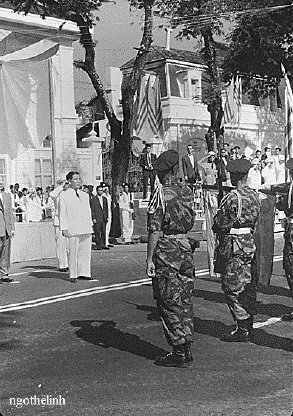
Diem - First
President of South Vietnam | | |
|
|
|
16.
|
Which of the following
statements is true
a. | Diem was a communist and would have
turned the country over to the North | c. | The death of Diem and his family made the leadership of North Vietnam
weak | b. | The death of Diem and his family left a power vacuum in South Vietnam with no
clear leader. | d. | The generals who took over after
Diem unified the country in strong opposition to the
North |
|
|
|
17.
|
The generals who overthrew and
murdered Diem had the support of
a. | the Johnson
Administration | c. | the Nixon
Administration | b. | the Kennedy Administration | d. | no American government officials |
|
|
|
GULF OF
TONKIN
Within weeks of
Diem's murder, President Kennedy was assassinated.
Vice President Lyndon Johnson assumed office determined
not to lose Vietnam to the communists. He kept former President Kennedy’s foreign policy
advisors. He sent Defense Secretary Robert McNamara to South Vietnam to re-pledge U.S. support.
In August 1964, the USS Maddox, an American destroyer on patrol in the Gulf of Tonkin,
exchanged fire with North Vietnamese torpedo boats. Two days later, the ship's captain reported
he was under attack again. Despite conflicting evidence, the Pentagon insisted there had been a
second unprovoked attack.
The incident prompted Johnson to push the Gulf of Tonkin
Resolution through Congress. The measure allowed LBJ to wage war in
Vietnam | 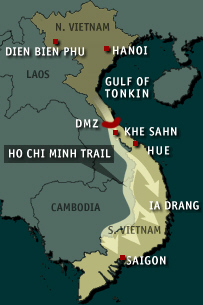 | | |
|
|
|
18.
|
Why did President Johnson push
for the Gulf of Tonkin resolution?
a. | He wanted to unify support in
Vietnam for the U.S. | c. | He wanted the
support of Congress so he could take further military action in
Vietnam | b. | He wanted North Vietnam to give us a naval
base | d. | He wanted the support of the former Kennedy administration
and the people of South Vietnam |
|
|
|
19.
|
Robert McNamara was a key
player in the Vietnam war. Who was he?
a. | U.S. Secretary of
State | c. | Democratic Council
Chairman | b. | U.S. National Security Advisor Chairman | d. | U.S. Secretary of Defense |
|
|
|
20.
|
Where is the Gulf of
Tonkin?
a. | South
Vietnam | c. | International
Waters | b. | Southern China | d. | North Vietnam |
|
|
|
21.
|
Who was president when the Gulf
of Tonkin incident took place?
a. | Kennedy | c. | Nixon | b. | Johnson | d. | McNamara |
|
|
|
ESCALATION
In March 1965, four months after Johnson was elected
president by a landslide, the first
U.S. ground troops landed at Da Nang.
Johnson was convinced that, without the support of a
massive U.S. force, South Vietnam was doomed. In response to the U.S. troop buildup, North Vietnam
began to send thousands of soldiers to fight in South Vietnam. In the Ia Drang valley in
Vietnam's central highlands, the North Vietnamese and U.S. armies met in the first major battle
of the war. It was an American victory -- but U.S. casualties were heavy.
American GIs,
meanwhile, found themselves in a baffling war. They were unable to distinguish friend from
foe. American bombing and shelling drove tens of thousands of Vietnamese from their villages.
American television networks kept a running tally of the U.S. "body count."
Johnson
attempted to force the North Vietnamese to the negotiating table by bombing North Vietnam --
including the Ho Chi Minh Trail, the primitive but highly effective supply line that linked North
Vietnam with its fighters and supporters in the South. But the tactic
failed
| |
|
|
|
22.
|
Why didn’t President
Johnson give military aide to the South and let them fight the war on their own?
a. | Congress was angry and wanted war
| c. | Johnson was a “war
monger” | b. | He did not think the South could win on their
own | d. | Johnson was a catholic and hated North
Vietnam |
|
|
|
23.
|
Which statement is
true
a. | Because the Vietcong hid among the
civilian population, the U.S. was forced to bomb many Vietnam villages and
farms | c. | The U.S. lost its first encounter
with the communists at the battle of Phu | b. | The U.S. won its first encounter with the Communists at Dien Bien
Phu | d. | all of these statements are
true |
|
|
|
24.
|
What is
“Escalation”
a. | Every time one side builds up its
forces, the other side builds up its forces too | c. | The Ho Chi Minh trail | b. | The body count goes higher and
higher | d. | Verbalization |
|
|
|
25.
|
In 1965, President Johnson
a. | had only weak support in the
U.S. | c. | decided to resign from
office | b. | was very unpopular because of the war | d. | was very popular in the United
States |
|
|
|
26.
|
Who was president with the war
ended in Vietnam
a. | Johnson | c. | Nixon | b. | Kissinger | d. | McNamara |
|
|
|
QUAGMIRE
The growing scale and savagery of the war in Vietnam
created growing dissent back in the United States. Johnson was politically weakened by the anti-war movement.
In 1968,
communist forces launched wide-scale attacks throughout South Vietnam to coincide with Tet, the
Vietnamese new year. The communists hoped to spark a general uprising across the country, a mission
that ultimately failed. But the strength of the offensive came as a shock to the American public and
Johnson.
He offered to begin peace talks with the North Vietnamese -- and announced he would not
run for another term in office.
In May 1968, peace talks began in Paris but soon deadlocked.
Richard Nixon, who had begun his campaign for the presidency, called for an "honorable"
end to U.S. military involvement in Vietnam. The North wanted full control of the South and the
U.S. believed it could not abandon South Vietnam. The war was to last another four years, costing
thousands more lives. President Nixon sent Henry Kissinger to negotiate with the North and a peace
treaty was eventually signed.
| |
|
|
|
27.
|
What was the
“quagmire” in Vietnam?
a. | The use of body count to measure the
success of the war | c. | Getting bogged
down in a long “never ending” war | b. | The request for peace talks in Quagmire
France | d. | The use of guerilla tactics by the
North |
|
|
|
28.
|
If the U.S. was supplying and
helping South Vietnam, who was helping and supplying North Vietnam?
a. | France and Soviet
Union | c. | China and
Laos | b. | Soviet Union and Cambodia | d. | Soviet Union and China |
|
|
|
29.
|
Why did the peace talks drag on
for so long?
a. | The U.S. did not want to sacrifice
the people of South Vietnam to the North | c. | The North did not want to return U.S.
prisoners | b. | North Vietnam wanted large sums of money from the U.S.
| d. | The South wanted more territory in the
North. |
|
|
|
30.
|
The Tet Offensive
was
a. | a psychological loss but a military
success for the North | c. | a military defeat
but a psychological victory for the North | b. | a psychological success and a military success for the
South | d. | a military success and a psychological success for the
North |
|
|
|
BUILDUP
Soviet leader Nikita Khrushchev wanted to remind the West
of his nation's power. On October 30, 1961, he broke a moratorium (agreement not to test) on
nuclear testing. A Russian bomber dropped the largest bomb the world had ever seen. Its explosion was
the equivalent of more than 50 million tons of TNT, more than all the explosives used in World War
II. It was so powerful that people 50 miles from ground zero were blown off their feet.
President
Kennedy, angered by the new Soviet tests, announced that the United States would proceed in its
development of nuclear weapons. But public opinion in the West was turning against the nuclear arms
buildup. In Europe, the Campaign for Nuclear Disarmament and other "ban the bomb" groups
began to emerge. Kennedy and his defense secretary, Robert McNamara, meanwhile, were having second
thoughts about the strategy of massive retaliation -- now it meant the United States would be
initiating the use of nuclear weapons against an equally equipped Soviet Union.
| 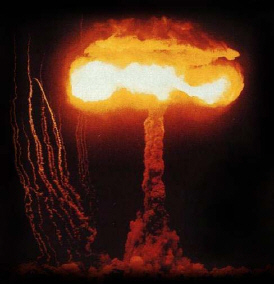
McNamara presented U.S. military planners with an appealing alternative: No
Cities/Counterforce. Soviet cities were no longer to be targeted, only Soviet military forces. But
the new strategy was dismissed by the Soviets as self-deluding. | | |
|
|
|
31.
|
Why did Khrushchev detonate the
massive hydrogen bomb in October 1961
a. | He wanted to impress the West with
Soviet power | c. | The Soviets were
trying to get rid of old weapons. | b. | The U.S. and the Soviets had an agreement that they could test whenever they
wanted | d. | He wanted to warn the Soviet people to remain loyal to
communism |
|
|
|
32.
|
Groups who were opposed to the
use of nuclear weapons in war were called
a. | military support
groups | c. | conservatives | b. | ban the bomb groups | d. | nuke-em groups |
|
|
|
33.
|
The Soviets thought that the
Kennedy administration idea that we should not target each other cities any longer was
a. | unrealistic | c. | something they were already doing | b. | a good idea | d. | hateful |
|
|
|
CLOSE CALL
In October 1962, the Cuban Missile Crisis brought the
world to the brink of nuclear war. For nearly two weeks, Moscow and Washington were involved in a
tense contest of wills over the presence of Soviet missiles in Cuba. Khrushchev, confronted by
Kennedy's nuclear superiority, backed down -- ending the crisis. But both sides were shocked at
how close they had come to nuclear war. They set up a "hot line," a direct communications
link between the Soviet and U.S. capitals.
Several months later, the Soviet Union, United States
and Britain agreed to a Limited Test Ban Treaty, ending atmospheric tests. Nuclear testing would
continue, but underground. The race to increase stockpiles continued as well, as the Kremlin --
smarting from the Cuban crisis -- vowed never again to confront America from a position of weakness.
A grim logic was beginning to emerge. Nuclear disarmament was not achievable, yet nuclear war was
unthinkable. The White House became convinced that the strategy of MAD, mutual assured destruction,
was the only deterrent to nuclear conflict |
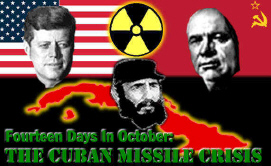
War?
 | | |
|
|
|
34.
|
How did the Soviets react to
the Cuban Missile Crisis?
a. | They cut back on the development of
more powerful bombs | c. | Proposed a ban on
nuclear weapons | b. | They built up their nuclear forces to become more of a nuclear
threat | d. | Destroyed all of their nuclear
weapons. |
|
|
|
35.
|
What did the U.S., Britain and
the Soviets do to ban atmospheric testing?
a. | Agreed to limit bombs to those
already in their stockpiles | c. | Agreed to test bombs underground | b. | Agreed to test only in the upper
atmosphere | d. | Agreed not to test any more
bombs |
|
|
|
36.
|
What was the purpose of
“the hotline?”
a. | To prevent accidental nuclear
war | c. | To warn the U.S. and the Soviets
that each were going to attack | b. | To warn the Soviets that we were going to
attack | d. | Allow government officials time to go to bunkers in case
of an attack |
|
|
|
37.
|
What was the “grim
logic” that emerged from the Cuban Missile Crisis?
a. | Neither the Soviets or the West
could disarm even though war was too horrible to think about | c. | The Cuban Missile Crisis was a logical
affair | b. | The Soviets and the West could not disarm for 100
years | d. | The Cuban Missile Crisis proved that safeguards against
war were in place and working well. |
|
|
|
38.
|
The MAD strategy
was
a. | a guarantee of
war | c. | developed in the Kennedy
administration | b. | a way to prevent war | d. | a comic book approach to world
affairs |
|
|
|
DETERRENCE
For MAD to succeed, each side needed to be able to
retaliate, even after it had suffered a surprise attack. Submarines now played a crucial role -- as
mobile launch platforms for nuclear missiles. Both sides practiced civil defense against nuclear
attack, but it was generally believed that it was impossible to defend against nuclear
weapons.
Even short of total war, nuclear deterrence carried its own dangers. In 1966 over the
coast of Spain, a U.S. bomber collided in mid-air with a tanker aircraft. As the planes crashed, four
hydrogen bombs were scattered over the coast. Three hit the ground and were recovered. One fell into
the sea and was lost for 80 days. Such "Broken Arrow" incidents were growing, as both sides
increased their nuclear arsenals
The U.S. had three methods of attack. These were long range
bombers, intercontinental ballistic missiles and nuclear submarines. Nuclear submarines were
especially lethal. They were designed to stay under water for long periods of time and were very hard
to detect. They could surface at any time and launch their missiles.
| 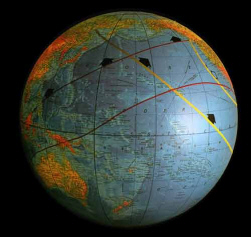
Soviet and U.S. missiles and bombers were designed to attack each other over the
North pole. That was the shortest route
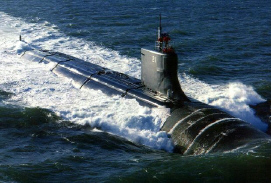 | | |
|
|
|
39.
|
The policy of Deterrence was
designed to prevent a war
a. | but accidents were
possible | d. | all of these
statements are true | b. | and it has been a success | e. | none of these statements are true | c. | and caused a generation of people to live in
fear |
|
|
|
40.
|
Civil defense refers to the
actions that the civilian population can take to protect against nuclear attack. Which statement
below is true about civil defense?
a. | Most people took civil defense
seriously | c. | The U.S. and
Soviets had no civil defense procedures at all | b. | Most people thought civil defense could not protect
them | d. | Civil defense was our first line of defense against
nuclear attack |
|
|
|
41.
|
What was the shortest route for
Soviet and U.S. missiles and bombers to attack each other.
a. | Over the North
Pole | c. | Across the Pacific
Ocean | b. | Across the Atlantic Ocean | d. | Through Normandy as was done in
WWII |
|
|
|
ANTI-MISSILES
The Soviet military was unconvinced by the MAD theory. They worked to develop
anti-ballistic missiles -- ABMs -- that could destroy U.S. missiles in flight. The introduction of
ABMs destabilized the concept of MAD. Tensions in the Middle East, brought on by the 1967 Six Day
War, prompted U.S. President Johnson and Soviet Premier Kosygin to meet for a summit. The issue of
ABMs was high on their agenda.
U.S. scientists, meanwhile, prepared a counter-measure: Multiple
Independently Targeted Re-Entry Vehicles -- MIRVs for short. One single missile could now carry 10
separate warheads, each capable of destroying a city.
Nixon the Peacemaker
By 1969, the superpowers were, between them, spending more than $50 million a
day on nuclear armaments. It was a burden both sides found intolerable, and it led to negotiations
known as SALT, the Strategic Arms Limitation Talks. SALT dragged on until 1972, when U.S. President
Nixon went to Moscow to sign the arms agreements with Soviet Premier Brezhnev. ABMs had now been
discredited, but the two sides could not come to a lasting agreement on offensive nuclear weapons.
Preparations for global annihilation continued.
| 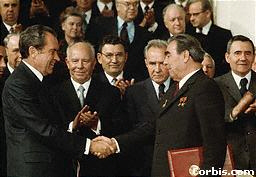
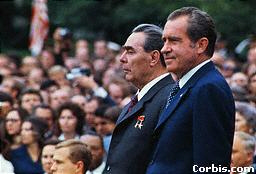
 | | |
|
|
|
42.
|
How did the Soviets try to
counteract the MAD theory
a. | By banning all nuclear
weapons | c. | By developing
ABMs | b. | By deploying MIRVs | d. | By appealing to the U.N. |
|
|
|
43.
|
Which missiles were designed to
carry 10 nuclear warheads that would spread out and destroy 10 cities instead of 1 when it came close
to its target?
a. | AbMs | c. | B1s | b. | MIRVs | d. | Stealth War Heads |
|
|
|
44.
|
Why were the Soviets and the
U.S. concerned about the Six Day War between Israel and it’s Arab
neighbors?
a. | Almost everything that happened
throughout the world was part of the cold war | c. | All of these a valid sources of concern for the Soviets and the
U.S. | b. | The U.S. was backing Israel while the Soviets were backing the Arab
states | d. | They were afraid that conflict in the Middle East could
cause a confrontation between the West and the Soviets |
|
|
|
45.
|
The SALT treaty
a. | successfully limited offensive
weapons between the Americans and Soviets | c. | was not agreed to be the Soviets | b. | was only partially successful but it was a
start | d. | was not agreed to by the
U.S, |
|
|
|
46.
|
Who signed the SALT treaty for
the U.S,?
a. | Truman | c. | Kennedy | b. | Johnson | d. | Nixon |
|
|
|
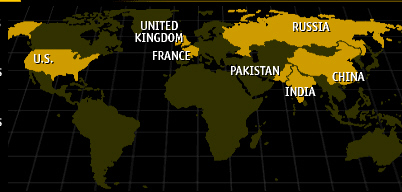 |
The Nuclear Club
Nations in the world that have nuclear
weapons | | |
|
|
|
47.
|
Which country below does
not have nuclear weapons
today?
a. | India | c. | China | b. | Pakistan | d. | Syria |
|
|
|
In the 1960s the United States claimed its
place as the world's leading defender against communism. But by the end of the decade, the
nation was convulsed by dissent, riot, assassination and an increasingly unpopular war.
HAVES/HAVE
NOTS
In 1960, John F. Kennedy
-- who seemed to many the embodiment of a new age -- was elected president of the United States.
Kennedy had attacked President Eisenhower's conduct of the Cold War and promised to defend the
free world against communism. He increased the U.S. military budget, creating thousands more defense
industry jobs.
But while the U.S. economy was booming, the good life was not available to all
Americans. In many Southern states, laws prevented blacks and whites from traveling together, eating
together, or even going to the same school. Black Americans were denied jobs and the right to vote.
Civil rights activists held peaceful demonstrations -- but were often beaten and jailed just the
same.
Gov. George Wallace of Alabama saw the growing civil rights movement as part of a communist
conspiracy -- a view shared privately by FBI Director J. Edgar Hoover. Discrimination against blacks
-- covered extensively on television -- damaged America's credibility as freedom's champion
in the Cold War.
In fact other people in the government suspected that the civil rights movement
might be part of some internal communist conspiracy and on the orders of Robert Kennedy, Dr. Kings
hotel rooms were bugged. Post cards were circulated showing Dr. King at a, “supposedly,”
communist meeting. Of course, none of this was true but it fed into the fear that Americans had about
communism abroad and at home.
|

John F.
Kennedy
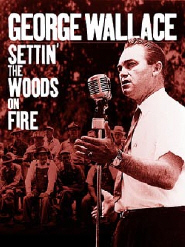
George Wallace, Governor of
Alabama | | |
|
|
|
48.
|
John F. Kennedy was known as
the “Peace” candidate yet he _____ the defense budget in the U.S. in contradiction to his
image.
a. | increased | c. | eliminated | b. | decreased | d. | exploited |
|
|
|
49.
|
Who was director of the FBI in
the early 1960’s
a. | George
Wallace | c. | Orville
Faubus | b. | J. Edgar Hoover | d. | Bob McNamara |
|
|
|
50.
|
George Wallace was a _____ who
fought _____ in the early 60’s
a. | libertarian -
segregation | c. | integrationist -
segregation | b. | Democrat - segregation | d. | segregationist - integration |
|
|
|
51.
|
How did some feel the civil
rights movement hurt the U.S. in the war against communism.
a. | the civil rights movement helped to
put spies in the Defense Department | c. | the movement made LBJ look like a
segregationist. | b. | the civil rights movement hurt the image of the U.S. around the world and made
it look just as bad as the Soviet Union | d. | resources were taken away from civil defense to pay for the civil rights
movement. |
|
|
|
THE GREAT
SOCIETY
Kennedy was
assassinated in November 1963. His successor, Lyndon Johnson, had a vision of the Great Society.
Central to that vision was a war against poverty and the abolition of racial discrimination. Johnson
was able to pass the Civil Rights Act in 1964 -- and later that year won an easy victory against his
Republican opponent, Sen. Barry Goldwater, who denounced Johnson's Great Society as creeping
socialism.
Johnson was an old FDR Democrat and he wanted to put in place many programs to help
the poor in America. Medicare and Medicade were two of his programs. In those days the Southern
Democrats had control of the Congress and usually blocked pro civil rights laws. Johnson had been
Majority Leader in the Senate before he became Vice President under Kennedy. He knew how to control
the Southern politicians and was able to get pro civil rights laws through the Congress. Johnson had
a vision for America but once he got bogged down in the Vietnam war he was never able to fully
implement his vision
Meanwhile, dissent was flourishing on America's campuses. At the
University of California at Berkeley, students borrowed the tactics of the Civil Rights Movement,
organizing strikes and sit-ins.
| 
Johnson sworn
into office after Kennedy’s assassination
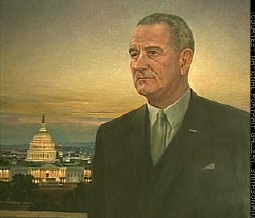
Lyndon Johnson and his vision
for America | | |
|
|
|
52.
|
What did President Johnson call
his vision for America?
a. | The New
Deal | c. | The Great
Society | b. | The Square Deal | d. | The Free Society |
|
|
|
53.
|
What was Lyndon Johnson’s
job in the Kennedy administration?
a. | Vice
President | c. | Minority Leader of
the Senate | b. | Majority Leader of the Senate | d. | Speaker of the House |
|
|
|
54.
|
Who was the Republican who ran
against Lyndon Johnson in 1964?
a. | Hubert
Humphry | c. | Barry
Goldwater | b. | Bobby Kennedy | d. | Gene McCarthy |
|
|
|
55.
|
Why was it so hard to get civil
rights laws through the Congress?
a. | Congress was controlled by the
Republicans | c. | Congress cared
more for national defense than civil rights | b. | Congress was controlled by the Southern
Democrats | d. | The KKK controlled
Congress |
|
|
|
56.
|
Lyndon Johnson never did get
all of the Great Society programs enacted. Why not?
a. | The Vietnam War made him loose the
support of the American people | c. | The Republicans ganged up on him | b. | Barry Goldwater blocked the Great
Society. | d. | FDR was against the Great
Society |
|
|
|
SEX and WAR
American ideals of political freedom were now being extended into the personal
realm. The availability of new birth control such as "The Pill" revolutionized many
peoples' views on sexual behavior. Many women burned their bra’s, they demanded equal pay
for equal work and they rebelled against being treated as “sex objects.” The National
Organization for Women was started by Betty Friedan
In 1965, Johnson began sending U.S. ground
troops to Vietnam. Despite the extension of the military draft, Johnson's efforts in Vietnam
enjoyed popular support. In the early 60’s people could easily see the connection between the
war in Vietnam and the larger cold war. People believed the “Domino Theory”
In the
early 60’s the United States was on the verge of tremendous social, political and ethical
changes that would come later in the decade. Few people saw it coming | | | |
|
|
|
57.
|
President Johnson was very
_____ in the early 1960’s
a. | ill | c. | unpopular | b. | hated | d. | popular |
|
|
|
58.
|
What did the Woman’s
Movement indicate about the 1960’s?
a. | The rest of the decade would be
quiet once women got their demands | c. | Woman would calm down as soon as they let off a little
steam | b. | The nation was going to experience some radical changes in the coming
years. | d. | Woman longed for the “good old
50’s” |
|
|
|
59.
|
Who started the National
Organization for Women (NOW)?
a. | Jackie
Kennedy | c. | Betty
Friedan | b. | President Johnson | d. | Hillary Clinton |
|
|
|
COUNTERCULTURE
While some Americans went off to war in Vietnam, others were challenging what
was termed "the Establishment." The Establishment was all forms of authority. They rejected
materialism -- not for communism but instead for love, peace, drugs and rock 'n' roll. All
over the United States, young men of draft age were turning on, tuning in and dropping out. These
counter culture young people were called, “hippies” by some.
A vast majority of
America spurned the new counterculture. But protests against the war were growing -- with marches and
draft-card burnings. Meanwhile, America's war in Vietnam dragged on. By 1967, 500,000 U.S.
soldiers were there. |
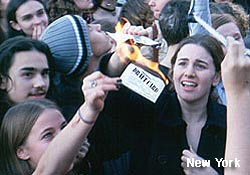 Burning draft cards
in defiance of the Establishment Burning draft cards
in defiance of the Establishment | | |
|
|
|
60.
|
What was the counter culture
for?
a. | the
Establishment | c. | sex, drugs and
rock and roll | b. | the war in Vietnam | d. | communism |
|
|
|
61.
|
The counterculture was a
symptom of
a. | social
unrest | c. | cultured
society | b. | social stability | d. | peace and stability |
|
|
|
62.
|
Which statement is
true?
a. | Most Americans supported the
counterculture | c. | A majority of the
young people were “turning on and dropping out” | b. | Most Americans were in support of the hippies because they
were their own kids | d. | A majority of Americans did not
support the counter culture movement |
|
|
|
63.
|
By 1967, how many soldiers were
fighting in Vietnam
a. | 100,000 | c. | 50,000 | b. | 1,000,000 | d. | 500,000 |
|
|
|
DISCONTENT
In America's inner cities, some black activists
trained as paramilitaries in what they saw as a civil war against a racist police force. Led by Huey
Newton, they called themselves the Black Panthers. The Panthers murdered a school superintendent in
Oakland. By the summer of 1967, discontent boiled over into riots in several major U.S. cities. By
March 1968, with a growing war in Vietnam and conflict at home, Johnson declared he would not run for
a second term as president.
1968 also saw the killings of two prominent Americans. Civil rights
activist Martin Luther King Jr. was shot dead by a white gunman. Several weeks later, Robert Kennedy
-- brother of the late president and himself a presidential candidate -- was killed while campaigning
in California To many it looked like the United States was on the verge of a
revolution.
|
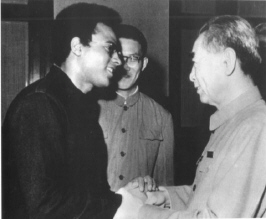
Black Panther
Huey Newton Visits Communist China | | |
|
|
|
64.
|
Who was leader of the Black
Panther Party?
a. | J. Edgar
Hoover | c. | Malcom
X | b. | Huey
Newton | d. | Angela Davis |
|
|
|
65.
|
The Black Panthers were
a. | anti
American | c. | anti
establishment | b. | pro Communist | d. | all of these |
|
|
|
66.
|
President Johnson decided not
to run for a second term because Bobby Kennedy and martin Luther King were
assassinated.
|
|
|
67.
|
After the assassination of Dr.
King there were major riots in many American cities
|
|
|
| CRACKDOWN
In August 1968, Democratic Party delegates arrived in Chicago to pick their
candidate for the November presidential elections. Along with the delegates came about 100,000
anti-war demonstrators. The protesters gathered in city parks in preparation for a march on the
convention hall. But Chicago Mayor Richard Daley had no intention of allowing them to take over the
convention . On the day the Democrats were due to nominate their presidential candidate, the
demonstrators battled with police.
The situation inside the convention hall was also combative.
Supporters of anti-war candidate Eugene McCarthy were prevented from debating the war. Vice President
Hubert Humphry became the Democratic presidential candidate. With a promise to crack down on
lawlessness, his Republican opponent, Richard Nixon, won the November elections by less than 1
percent of the vote. The Cold War, and the war in Vietnam, would
continue
| | |
|
|
|
68.
|
At what convention did the
Chicago riots take place”
a. | Democrat
convention | c. | SDS
convention | b. | Republican convention | d. | Mayors convention |
|
|
|
69.
|
Who was nominated by the
Democrats to run for president in 1968
a. | Richard
Nixon | c. | Gene
McCarthy | b. | Hubert Humphry | d. | Bobby Kennedy |
|
|
|
70.
|
Who was nominated by the
Republicans to run for president in 1968
a. | Richard
Nixon | c. | Gene
McCarthy | b. | Hubert Humphry | d. | Dwight Eisenhower |
|
|
|
71.
|
Who won the election and was
elected President of the U.S. in 1968?
a. | Hubert
Humphry | c. | Dwight
Eisenhower | b. | Richard Nixon | d. | Lyndon Johnson |
|
|
|
72.
|
Why didn’t Lyndon Johnson
run for a second term?
a. | He wanted to spend time with his
family | c. | He thought he could not win because
of the chaos and protests around the country | b. | He wanted to retire to
Texas | d. | His wife would no let him run
again |
|
|
|
The emergence of the People's
Republic of China signals a new and dangerous phase in the Cold War. But later on (through the
efforts of Richard Nixon), a split between Moscow and Beijing opens the door for a change in
U.S.-Chinese relations.
A NEW
CHINA
For many years the United States and China had been allies. Americans felt a special
bond to the Chinese people. It was because of Japan’s invasion of Chinese Manchuria that the
U.S. placed an embargo on Japan, leading to the attack on Pearl Harbor. In dismay, America watched
its former ally become its enemy.
In 1949, the People's Liberation Army arrived in Beijing --
celebrating a communist victory and the end of their decades-long civil war against the Nationalists.
Led by Mao Tse-tung, the communists establish the People's Republic of China. The U.S.
government, which had considered China among its allies in Asia, is devastated by the
"loss" of China to the communists. | 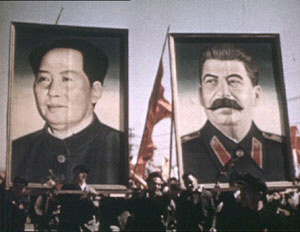
Mao and Stalin
Exhausted by the long war, Mao needed external
help for China's reconstruction. One of his first acts is to visit Moscow, seeking military
protection and economic aid. Mao wanted to conclude a Chinese-Soviet friendship treaty with Stalin --
but the two leaders remained wary of each other. After several months of negotiation, the Chinese and
the Soviets signed a mutual defense treaty -- which also guaranteed aid for China. For Stalin it was
proof that communism was the wave of the future. The largest nation in the world was now
communist. | | |
|
|
|
73.
|
What is the largest communist
nation in the world?
a. | China | c. | Soviet Union | b. | Russia | d. | Eastern Europe (including East
Germany) |
|
|
|
74.
|
Who were the communists
fighting in the civil war in China?
a. | The
Socialists | c. | The
nationalists | b. | The Capitalists | d. | The democrats |
|
|
|
75.
|
What did Mao need from
Stalin?
a. | military
protection | c. | military
protection and economic aid | b. | economic aid | d. | military aid and economic
protection |
|
|
|
76.
|
Why did the U.S. place an
embargo on Japan in the 1930’s
a. | Japan invaded Chinese
Manchuria | c. | Japan was selling
too many cars in the U.S. | b. | Japan invaded Korea | d. | Japan was trying to control the TV
business. |
|
|
|
REFORM/WAR
China's new rulers embarked on radical land reforms.
Land was taken from private owners and handed to the peasants. Former landowners were denounced and
humiliated. One million people lost their lives. Later the land was taken from the peasants and
turned over to the communist government.
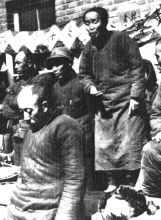
Former land owners put on
trial
| 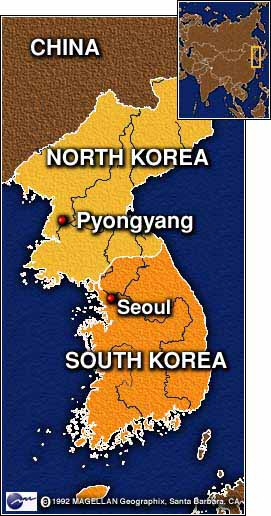 | | |
|
|
|
77.
|
After the communists took over
in China, land was taken from the former owners and given to the peasants. This was called
a. | commune
farming | c. | land
reform | b. | proletariat farming | d. | peasant power |
|
|
|
78.
|
Who, eventually, controlled all
of the land in China?
a. | The former
owners | c. | The
capitalists | b. | The peasants | d. | The government |
|
|
|
79.
|
Which countries supported North
Korea’s attack on South Korea?
a. | The
Soviets | c. | The Soviets and
the Chinese | b. | The Chinese | d. | The Soviets, Chinese and
Vietcong |
|
|
|
80.
|
Why did China attack the U.N
forces in Korea
a. | They did not like the
U.N. | c. | They wanted to use Korea as a
staging area to attack Japan | b. | They wanted to make sure North Korea stayed
communist | d. | They wanted a unified
Korea |
|
|
|
81.
|
China shares a border with
a. | South
Korea | c. | The United
Nations | b. | North Korea | d. | Japan |
|
|
|
TENSIONS
Stalin's death in 1953 had a deep impact in China.
Despite Mao's misgivings, he had long respected Stalin's iron authority. Nikita Khrushchev
soon emerged from the Kremlin power struggle as the new Soviet leader and Mao was not sure he was a
powerful leader.. Khrushchev and his Politburo visited China to maintain the Beijing-Moscow alliance
-- a move that made the new Eisenhower administration in Washington increasingly anxious. As part of
its policy to contain communism, the United States financed a military buildup on Taiwan -- home for
the Chinese Nationalists.
But Mao
did not give way to the American show of strength. His forces shelled the Nationalist-held islands of
Quemoy and Matsu in the Taiwan Straits. | 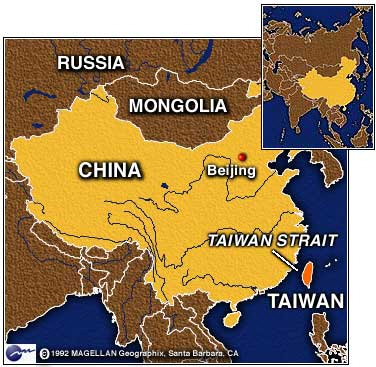 The U.S. sent its fleet to patrol
the Taiwan Straits and also to send a message to Communist China that it had better not invade
Taiwan. Mr. Schneemann was in the Taiwan straits during the shelling so China backed off. The U.S. sent its fleet to patrol
the Taiwan Straits and also to send a message to Communist China that it had better not invade
Taiwan. Mr. Schneemann was in the Taiwan straits during the shelling so China backed off.
The
rising U.S.-Chinese tensions concerned Khrushchev -- who told Beijing that war with imperialism was
no longer inevitable. | | |
|
|
|
82.
|
What is the capital of the
Soviet Union
a. | Beijing | c. | Stalingrad | b. | Moscow | d. | Taipei |
|
|
|
83.
|
What is the capital of
China?
a. | Beijing | c. | Moscow | b. | Taiwan | d. | Kaoshung |
|
|
|
84.
|
A body of water between two
land masses is called
a. | an
island | c. | a
straight | b. | an inland sea | d. | a gulf |
|
|
|
85.
|
What was the Beijing-Moscow alliance?
a. | An alliance between Taiwan and
Moscow | c. | An alliance between China and
Russia | b. | An alliance between China and Taiwan | d. | An alliance between the Soviets and
Asia |
|
|
|
86.
|
Who were the Chinese
Nationalists?
a. | They fought against the communists
in the China civil war | c. | They were the
Chinese communists | b. | They fought against China in the Korean war. | d. | They were allies of the Soviet Union and that is why Mao was nervous about
them. |
|
|
|
87.
|
Taiwan used to be called
Formosa. Who controlled Taiwan in the 50’s and still does today?
a. | The Chinese
Communists | c. | The North
Koreans | b. | The Chinese Nationalists | d. | The U.S. and Japan |
|
|
|
88.
|
Who was president of the U.S.
when Stalin died in 1953?
a. | Kennedy | c. | Eisenhower | b. | Truman | d. | Nixon |
|
|
|
SPLIT
Khrushchev's attempts to steer the U.S.S.R. away from its Stalinist past
-- and his denunciation of Stalin as a criminal -- alarmed Mao, who took such actions as a threat to
his own style of leadership. China, meanwhile, was chafing over Soviet attempts to control the
Beijing government. In the late 1950s, Khrushchev visited China at least twice to renew Soviet
support.
China and the Soviet Union share a very long border. China had long considered parts of
Russian Siberia to be part of China. Both China and Russia had large numbers of troops stationed on
their borders and there were minor conflicts from time to time.
But China's relations were
already strained with its declared "big brother," and the Soviet leader could find no
common ground with Chinese officials. Khrushchev, who had recently visited the United States, was
accused by the Chinese of being an American stooge. Soon afterward, Soviet advisers were withdrawn
from China. The struggle for pre-eminence in the communist world was now out in the open.
| | | |
|
|
|
89.
|
Soon after coming to power,
Khrushchev made a speech called, “Crimes of the Stalin Era,” in which he condemned Stalin
for his brutal policies. Why would this alarm Mao Tsi Tung, the leader of China.
a. | Mao was a friend of
Stalin | c. | Mao wanted China to become part of
Russia | b. | Mao helped Stalin with his purges in Russia | d. | Mao behaved similar to Stalin and thought Khrushchev might come after him
next |
|
|
|
90.
|
How did Mao feel about Soviet
attempts to control his nation?
a. | He resented
it | c. | He welcomed it because he believed
that the Russians were smarter than the Chinese | b. | He welcomed it because China had many problems that Mao
could not solve | d. | He ignored
it |
|
|
|
91.
|
Why did Mao call Khrushchev a
“U.S. stooge?”
a. | Khrushchev visited the U.S.
| c. | Khrushchev became a
capitalist | b. | Khrushchev took down the Berlin wall at America’s
request | d. | Khrushchev gave up his idea of Soviet domination of
Eastern Europe |
|
|
|
92.
|
Even though there were problems
between the Soviets and China, they were still communist and united in there desire to make the
entire world communist.
|
|
|
|
|
|
93.
|
Mao’s, “Great Leap
Forward” can be characterized as
a. | a small
failure | c. | a disaster for
China | b. | a break even policy for China | d. | a moderate success |
|
|
|
94.
|
When the leadership of the Mao
government was threatened, how did they react?
a. | they called out the Chinese military
to suppress revolt against the Mao government | c. | They looked for ways to reform the culture and make it more open and
democratic. | b. | they mobilized the young people into a cultural revolution that persecuted
everyone who did not support Mao | d. | They turned away from the Soviets and toward
capitalism. |
|
|
|
95.
|
Who were the Red
Guards”
a. | young people who supported
Mao | c. | military people who were against
Mao | b. | intellectuals and scientists who supported
Mao | d. | young people who condemned
Mao |
|
|
|
PINGPONG
DIPLOMACY
Mao, fearful of
Moscow's belligerence, decided he wanted better relations with the United States. The new U.S.
President, Richard Nixon, was a lifelong anti-communist. But Nixon, wanting to limit Soviet power and
end the Vietnam War, drew closer to China. The first sign of a thaw in U.S.-Chinese relations came in
1971 -- when a U.S. table tennis team, playing in Japan, was suddenly invited to China.
For years
there had been no contact between China and the U.S. To most Americans, China was a mysterious
communist nation that we had to fear. When China invited the U.S. ping pong team to compete in China
most Americans welcomed the thaw in relations.
The so-called "pingpong diplomacy" led
to more breakthroughs -- culminating with Nixon's historic trip to China in February 1972. The
visit was mostly symbolic -- formal diplomatic relations were not restored until 1979 -- but it
helped reduce tensions between the two nations and brought new pressure on a shared rival: the Soviet
Union.
The Soviet Union was now afraid that China might align itself with the U.S. against
Russia. Because Nixon had been such a strong anti-communist, people trusted him and believed that
communist China could not take advantage of him. Most historians agree that Nixon was a genius in
foreign affairs and his visit to China was the beginning of the end of the cold
war.
|

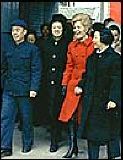

Pingpong
Diplomacy Resulted in Nixon’s Visits to China | | |
|
|
|
96.
|
There is a famous saying,
“Only Nixon Could Go To China.” What does that ;phrase mean.
a. | The Chinese did not trust
Democrats | c. | Since Nixon had
the reputation of being an anti-communist, the American people trusted him to deal with
China. | b. | Nixon was not very bright so the Chinese communists trusted
him | d. | Nixon was president when the ping pong team was invited to
China |
|
|
|
97.
|
Nixon and his National Security
Advisor, Henry Kissinger, caused the split between the Soviets and China to grow wider. This split
had the effect of drawing China and the Soviets closer to the United States. After 1972 China looked
to the U.S. as _____ Russia.
a. | an enemy of
Russia | c. | an allie
of | b. | a balance
against | d. | the leader of
|
|
|
|
| GUATEMALA
The United
States had a long standing policy called the Monroe Doctrine which said that European
countries should not meddle in the affairs of nations in the America’s. The U.S. reasoned that
countries that became communist would be under the control of the Soviet Union, as was the case in
Cuba. The U.S. felt that by enforcing the Monroe Doctrine it was preventing a European country,
Russia, from taking control of a nation in the America’s.
Central
America, the Caribbean and South America become the battleground for a test of wills between the
United States and the U.S.S.R. -- as the Cold War comes to America's "backyard."
After World War II, growing nationalism in Central and South America led to greater resentment
against the United States, whose government and business interests dominated the region. At that time
in Guatemala, the railroad, the main port, telecommunications and about 500,000 acres of land were
owned by the United Fruit Company of Boston.
In 1950, Jacobo Arbenz was voted Guatemala's
president. Arbenz wanted to modernize Guatemala's backward society and started a land reform
program, nationalizing thousands of acres of land -- some of it owned by United Fruit. Officials in
Washington were alarmed and suspected communist infiltration of the Arbenz government. Arbenz
wasn't a communist, but some of his allies were.
The CIA organized an operation code-named
"PB Success," which mobilized disaffected Guatemalan exiles and peasants into action. The
PB Success campaign brought down Guatemala's government and drove Arbenz and his wife into
exile. Some 9,000 of his supporters were arrested. Among those who fled Guatemala was a young
Argentine doctor, Che Guevara -- who went to Mexico, where he met Cuban rebel leader Fidel Castro.
| |
|
|
|
98.
|
What company controlled large
parts of the Guatemala economy during the cold war.
a. | United Fruit of
Boston | c. | U.S. Steel and
Fruit | b. | Guatemala utilities corporation | d. | Central America Fruit |
|
|
|
99.
|
Why did American officials
suspect that Jacobo Arbenz might be a communist?
a. | Many of his associates were
communist | c. | Both of these
answers are true | b. | He used land reform to confiscate farm land the way other communists had done
in Cuba and China | d. | Neither of these reasons suggest
that he is a communist |
|
|
|
100.
|
Why did the CIA help to bring
down the Guatemala government?
a. | The U.S. did not want Che Guevara to
take over Guatemala and Mexico | c. | The U.S. thought that a communist government in Central America was a threat
to U.S. security | b. | Both of these are true | d. | Neither of these reasons are
true |
|
|
|
101.
|
What was the name of the U.S.
policy that said the Europeans had to stay out of the American hemisphere?
a. | The CIA handbook on rules of
engagement | c. | The Communist
Manifesto | b. | The Emancipation Proclamation | d. | The Monroe Doctrine |
|
|
|
CUBA
By the end of the 1950s, Fidel Castro and Che Guevara had
triumphed in Cuba -- establishing a communist regime that soon allied itself with the Soviet Union.
In 1961, the new U.S. president, John F. Kennedy, inherited a CIA scheme to send an army of exiles to
Cuba to overthrow Castro -- a plan that had worked earlier against Arbenz in Guatemala. But the
CIA-sponsored Bay of Pigs invasion against Castro was a disaster.
After defeating the U.S.-backed
forces, Castro wanted to take armed revolution into Central and South America. By the early 1960s,
left-wing groups were fighting the authorities in Guatemala, Venezuela, Colombia and Peru. The United
States grew nervous; in 1965, U.S. Marines were sent to the Dominican Republic to end a democratic
revolution that Washington believed was backed by the Cubans. Cuba's real efforts to export
revolution, meanwhile, met with mixed results. In 1967, Che Guevara, who had called for "100
Vietnams," was captured alive in the jungles of Bolivia and shot dead hours later.
| |
|
|
|
102.
|
Fidel Castro and Che Guevara
were a threat to the U.S. because
a. | they wanted to control the fruit
market | c. | they wanted to export communism to
the U.S. | b. | they were communists and would probably allow the Soviets to establish bases
in Central America | d. | All of these are
true |
|
|
|
103.
|
Many Americans had helped Fidel
Castro to come to power in Cuba and were shocked to learn that he was a communist. What did Castro do
after he came to power in Cuba?
a. | Tried to overthrow the government of
the United States | c. | Established
peaceful relationships with the other governments of Central
America | b. | Told the Soviet Union it could not establish communist control in Central
America | d. | Tried to start other communist revolutions throughout
Central America |
|
|
|
104.
|
When Che Guevara called for 100
Vietnams he was
a. | calling for North Vietnam to take
over in Central America | c. | peaceful relations
with the U.S. | b. | calling for war against the U.S. | d. | an alliance with the U.S. like South Vietnam
had |
|
|
|
105.
|
Why did President Eisenhower
send marines to the Dominican Republic
a. | The Soviets were installing missile
bases in the Dominican Republic | c. | He wanted to establish a U.S. base there | b. | He wanted to stop Dominican
immigration | d. | He thought the revolution there was
backed by communist Cuba |
|
|
|
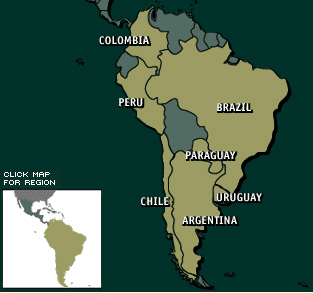 | CHILE
Chile had been calm in the 1960s. But in 1970 a left-center coalition sought
electoral victory. Unidad Popular was led by a Marxist doctor, Sen. Salvador Allende. U.S. businesses
and the CIA tried -- and failed -- to prevent Allende from being elected president of Chile.
Allende's first big step was
the nationalization of copper, Chile's biggest industry, which was still effectively under U.S.
control. He pressed on with what he called his "Social Revolution." Chilean peasants began
to seize land. The Chilean economy was increasingly put under state control -- a move that upset
overseas financiers. The World Bank cut off credits to Chile. | | Inflation and economic problems
mounted. CIA money helped pay for Chilean truck owners to bring the country to a standstill. At the
United Nations, Allende accused telecommunications conglomerate ITT of trying to provoke a civil war.
On September 11, 1973, Allende was violently ousted by the head of his military, Gen. Augusto
Pinochet. Allende was found dead after the Moneda, the presidential palace, had been set ablaze.
Following the coup, Pinochet had hundreds of political suspects rounded up. Many were never seen
again. | | |
|
|
|
106.
|
The events in Chili after
Allende took power most closely resemble the events in _____ after ______
took power
a. | Cuba - Che
Guevara | c. | Bolivia - Che
Guevara | b. | Cuba - Castro | d. | China - Khrushchev |
|
|
|
107.
|
The Marxist economic policies
under Allende
a. | were good for most of the people of
Chili and resulted in prosperity | c. | were a disaster for Chili and helped to cause civil
unrest | b. | were favored by the U.S. | d. | would eventually lead to
Capitalism |
|
|
|
108.
|
During the Cold War civil
unrest, and Marxist leaders brought many countries under the control of communist governments that
eventually became client states of the Soviet Union. The U.S. saw that happening in Chili and were
happy when _____ took control and brought a pro West government to power in
Chili
a. | Gen. Augusto
Pinochet | c. | Che
Guevara | b. | Salvador Allende | d. | General Carl Marx |
|
|
|
109.
|
The philosopher who developed
modern communism was Karl Marx. Those leaders who described themselves as Marxists were assumed by
the U.S. to be communists. Which of the people below described themselves as
Marxists?
a. | Castro | c. | Guevara | b. | Alliende | d. | all of these |
|
|
|
110.
|
Chili is a country in
a. | Central
America | c. | The
Caribbean | b. | South America | d. | North America |
|
|
|
| CENTRAL AMERICA
In the 1930s in Nicaragua, U.S. Marines had helped put
dictator Tacho Somoza into power. Forty years later, Nicaragua was still ruled by a Somoza. After
years of fighting, guerrillas who called themselves Sandinista, after the name of a 1930s anti-U.S.
rebel, ousted Somoza in 1979. The Sandinistas allied themselves with Cuba and attempted to bring a
Marxist order to their country. But they found themselves being challenged by a counter-rebellion --
the Contras.
At the same time, in neighboring El Salvador, protests had broken out against
right-wing military rule. Catholic Archbishop Oscar Romero was among those who spoke out. In March
1980, as he was saying Mass in a private chapel, the archbishop was assassinated. At Romero's
funeral, mourners were fired upon -- and many died. Later in the year three U.S. nuns and a female
lay worker were kidnapped, raped and killed by men later discovered to be part of El Salvador's
National Guard. The U.S. briefly, and temporarily, withdrew aid to the Salvadoran military.
Meanwhile, Salvadoran guerrillas expanded their campaign against the government
One of the reasons
the U.S. was concerned about Marxist revolutions in Central and South America was the :Panama Canal.
The Panama Canal is America’s link between the Atlantic and Pacific oceans The U.S. was
concerned that the Soviets would control traffic through the Canal if Marxists took control of the
Caribbean.
| |
|
|
|
111.
|
What was the name of the
Marxist rebel group fighting against the government in Nicaragua?
a. | the
Contras | c. | the
Somozas | b. | the Sandinistas | d. | the CIA |
|
|
|
112.
|
What was the name of the pro
U.S. leader of Nicaragua who was trying to fight off the Marxist rebels?
a. | Manuael
Contra | c. | Jose
Sandinistas | b. | Somoza | d. | Guevara |
|
|
|
113.
|
What was the name of the
counter-rebel group fighting against the Sandinistas?
a. | the
Contras | c. | the
Pan | b. | the Marxist Brigade | d. | the Pri revolutionary party |
|
|
|
114.
|
What did the U.S. do in
response to the killing of three nuns in El Salvador in the 80’s?
a. | It send marines to restore
peace | c. | it withdrew aid from the El Salvador
government | b. | it increased aid to the El Salvador
government | d. | nothing |
|
|
|
115.
|
The U.S. believed that _____
could control shipping in the Caribbean if local communists were to take control of Central American
governments.
a. | China | c. | Capitalists | b. | the Soviet Union | d. | Great Britain |
|
|
|
| ENGAGEMENT
As the fighting continued in Central America, Washington
was planning another operation -- on the British-governed Caribbean island of Grenada. When
Grenada's left-wing prime minister, Maurice Bishop, was assassinated by extreme Marxists in
1983, the U.S. military had an invasion plan ready for Reagan's approval. The Marxists were
building an airfield that could accommodate Soviet military planes and the U.S. believed this was an
attempt to establish a Soviet military base in the Caribbean. Reagan sent marines to Grenada and the
invasion, weakly opposed by a group of Cuban advisers on Grenada, was over in a few days. Within six
weeks, the invasion was a success and American troops left Grenada
The Reagan administration also
was funding Nicaragua's Contra rebels. At first the U.S. Congress supported the Contras but then
cut off aid to them. The Reagan administration believed that it was wrong to send the Contras into
battle and then withdraw aid from them. An aide to Ronald Reagan, named Oliver North, came up
with an idea to support the Contras. He sold military supplies to Israel who then sold the supplies
to Iran. Oliver North then used the money to buy military supplies for the Contras. The affair became
known as “The Iran-Contra
scandal.” Congress held hearings on the matter but the American public clearly supported
Colonial North.
By 1990, Nicaragua agreed to open and free elections, and Sandinista leader
Daniel Ortega asked the Nicaraguan people to elect him president. His opponent was Violeta Chamorro,
the widow of Pedro Joaquin Chamorro, an opposition leader killed during the Somoza regime. When the
votes were tallied, Chamorro won a narrow, yet stunning victory. The superpower struggle in Central
America had given way to a quiet revolution at the ballot box and a government opposed to communism
had won.
| |
|
|
|
116.
|
Why did the U.S. invade
Grenada
a. | Grenada was building an airfield big
enough to accommodate Soviet military aircraft. | c. | The Grenada army was threatening its
neighbors | b. | Grenada refused to ship oil and banana’s to the
U.S. | d. | Grenada was sending revolutionary agents into the
U.S. |
|
|
|
117.
|
Who was funding the
Nicaragua's Contra rebels?
a. | The Soviet
Union | c. | China | b. | Cuba | d. | The Reagan
Administration |
|
|
|
118.
|
What was the money from the
Iran Contra scandal used for?
a. | purchase arms for the Contras in
Nicaragua | c. | provide funds for
the Reagan administration | b. | purchase arms for the Contras in Cuba | d. | make Oliver North rich |
|
|
|
119.
|
Who was president of the U.S.
for most of the 1980’s
a. | Lyndon
Johnson | c. | Ronald
Reagan | b. | Jimmy Carter | d. | Richard Nixon |
|
|
|
120.
|
What country was
not involved in the Iran-Contra
scandal?
a. | Iran | c. | Cuba | b. | Israel | d. | the United States |
|
|
|
121.
|
When the people of Nicaragua
were given a chance to vote for the government of their choice they elected
a. | a communist
government | c. | a pro Soviet
government | b. | a non-communist government | d. | a Cuban style government |
|
|
|
122.
|
Who was the person or persons
who conceived and carried out the Iran-Contra deal?
a. | Daniel
Ortega | c. | Colonial Oliver
North | b. | Pedro Joaquin Chamorro | d. | Ronald Reagan |
|
|
|
COUP
In the 1970s, Afghanistan became a focus of superpower
rivalry. Geographically strategic -- near Persian Gulf oil and Indian Ocean ports, and bordering the
Soviet Central Asian republics -- a friendly Afghanistan was vital to Moscow's interests.
The Soviet Union sent hundreds of advisers to Kabul following an April 1978 military coup that
brought a left-wing regime to power. Led by Nur Mohammed Taraki, the new regime began reforming
Afghanistan by decree -- taking land from the owners and giving it to the peasants who worked it.
Women were encouraged to stop wearing veils, and were placed in literacy classes alongside men. In
the countryside, these reforms were seen as threats to ancient customs and the authority of the
mullahs -- the Islamic priests. Opponents of reform burned down schools. Thousands fled to
neighboring Pakistan to avoid the turmoil.
In Washington, National Security Adviser Zbigniew
Brzezinski was convinced that the new Afghan regime -- coupled with the overthrow of the shah in
neighboring Iran -- constituted a major threat to the West. He advised President Carter that Moscow
might use the Afghan crisis to move south and seize the Persian Gulf's oil. The U.S. soon began
sending covert aid to Islamic groups fighting the communists. The rebels called themselves the
Mujahedeen, or Soldiers of God. They were mostly peasants, organized by village mullahs and
landowners, with weapons captured from the communists. Moscow propaganda portrayed the Soviet-trained
Afghan government army as a motivated, mechanized force. But in reality, thousands of Afghan
government soldiers were deserting each month. Kabul pleaded with Moscow to send Soviet troops.
Soviet leaders discussed the crisis, but took no action -- until mobs massacred Soviet advisers and
their families in the Afghan city of Herat. Soon after, Kabul's request for Soviet troops moved
to the top of the Kremlin's agenda.
| |
|
|
|
123.
|
Why was Afghanistan an important part of the Cold War?
a. | China wanted to claim part of Afghan
territory | c. | It was important
to the Soviet Union interests in the Middle East | b. | It was not important in the Cold
War | d. | The U.S. needed Afghan
oil |
|
|
|
124.
|
Land reform is an idea that we
see over and over each time communists take control of a country. What is land
reform?
a. | modern farming methods are
instituted | c. | farm land is taken
from the owners and given to the peasants | b. | crop rotation is started to improve the quality of the
soil | d. | land is taken out of farming and used for new housing
developments |
|
|
|
125.
|
When the Soviets moved into
Afghanistan they tried to make reforms regarding women. These reforms were opposed by the strict
Muslim religious leaders of Afghanistan. Which of the following were reforms tried by the
Soviets
a. | allowing girls to go to
school | c. | encouraging women to stop wearing
veils | b. | allowing girls to participate in Afghan
society | d. | all of these |
|
|
|
126.
|
From the passage above we can
infer that the Soviets had some influence in the _____ but not much in the _____
.
a. | countryside -
cities | c. | churches -
schools | b. | cities - countryside | d. | churches - government |
|
|
|
127.
|
When the Soviets moved into
Afghanistan with advisors, Jimmy Carter was president. His National
Security Adviser was named
a. | Bob
McNamara | c. | Henry
Kissinger | b. | Nelson Rockefeller | d. | Zbigniew Brzezinski |
|
|
|
128.
|
Afghanistan is just South of
the Soviet Union and close to the oil fields in the middle east. The U.S. thought the Soviets were
moving into Afghanistan so it could position itself to take control of the Middle East oil. How did
the U.S. respond to the Soviets?
a. | The U.S. sent arms and advisors to
the Afghan rebels who were fighting against the Soviet controlled Afghan
government | c. | The U.S. sent
troops into Afghanistan to fight alongside the Afghan rebels who were fighting against the
Soviets | b. | The U.S. did nothing | d. | The U.S. invaded Iraq to be close to Afghanistan in case they were
needed |
|
|
|
129.
|
When the Afghan Muslims started
murdering Soviet advisors, what did the Soviets do?
a. | Made Afghanistan a priority and
started to move in troops | c. | Went after the religious Muslim leaders who were inciting the
violence | b. | Got ready to pull out of Afghanistan | d. | The Soviets did nothing |
|
|
|
INVASION
In Afghanistan, President Taraki's prime minister,
Hafizullah Amin, launched a campaign of terror -- having opponents arrested and shot. Concerned,
Taraki flew to Moscow to talk with Soviet leader Leonid Brezhnev about how to curb Amin's
excesses. They decided to oust him, hoping the Kabul government could gain popular support by slowing
the reforms and ending the terror. But Moscow's secret plans leaked out, and when Taraki
returned to Kabul, Amin had him seized and executed.
Amin, realizing the Soviets wanted him gone,
began to seek better ties with the West. But this only fueled speculation in Moscow that Amin might
be a CIA agent, and arguments mounted for an invasion to remove him. With the announced deployment of
U.S. cruise missiles in Europe, Moscow felt it had little to lose internationally by intervening in
Afghanistan with troops. In December 1979, the Politburo held an emergency meeting and made its
fateful decision -- hoping the mission would end within weeks. By December 25, tens of thousands of
men in tanks and trucks began to cross the Afghan border.
KGB special forces stormed the old
royal palace on the edge of Kabul, which had become Amin's favorite residence. The prime
minister tried to hide, but he was shot dead. Moscow replaced Amin with a more manageable leader,
Babrak Karmal. Since the Cold War started, the Soviet Union had used military action to topple
troublesome leaders in Hungary and Czechoslovakia -- but never had it invaded a country beyond the
borders of the Warsaw Pact. Now Soviet forces had crossed the line.
| |
|
|
|
130.
|
The Marxist Prime Minister of
Afghanistan, Hafizullah Amin, was put in power by the Soviets. He tried to
kill everyone who was opposed to him. The Soviets thought he was too extreme and caused the people to
be against the Soviet backed government. What did the Soviets do about Amin?
a. | Left him in power because he was a
Marxist | c. | Exiled him to
Iran | b. | Plotted to have him removed and executed | d. | Removed him from the presidency |
|
|
|
131.
|
In what year did the Soviets
decide to invade Afghanistan with thousands of Soviet troops?
|
|
|
132.
|
After the Soviets invaded, what
did they do about Prime Minister Amin?
a. | the CIA killed him and installed a
new prime minister, Babrak Karmal | c. | the KGB killed him and installed a new prime minister,
Babrak Karmal | b. | The Soviets left him in power because he was easy to work
with | d. | the kGB exiled him and left the office of Prime Minister
vacant |
|
|
|
RESPONSE
At the United Nations, the Soviet invasion was widely
condemned. In Washington, President Carter blocked grain deliveries to the Soviet Union, launched a
boycott of the 1980 Olympic Games in Moscow and stepped up U.S. arms spending. He sent his national
security adviser to Pakistan to rally resistance. Brzezinski wanted to arm the Mujahedeen without
revealing America's role, and sought the help of Pakistan's military ruler, Gen. Zia-ul-Haq
-- despite his poor record on human rights, nuclear weapons and drug trades.
With the election of
Republican Ronald Reagan as U.S. president in 1980, American covert military aid to the Afghan rebels
only increased. Money and arms were channeled through Pakistan -- which controlled the way aid was
distributed among the many Mujahedeen factions. Pakistan hoped to install a fundamentalist Islamic
regime in Afghanistan.
Meanwhile, as fighting escalated, the United Nations sought a diplomatic
solution -- a deal for a Soviet withdrawal from Afghanistan, if military aid to the Mujahedeen was
stopped. Hope for the plan blossomed in Moscow when, following the death of Brezhnev, the new Soviet
leadership indicated it might accept the U.N. proposal. But the United States and Pakistan were not
ready to cut a deal with Moscow.
| |
|
|
|
133.
|
Jimmy Carter was elected
president in 1976 and was in office when the Soviets invaded Afghanistan. What did he do about the
invasion.
a. | Boycott the Olympic games in
Moscow | d. | supplied weapons to the Mujahedeen who were fighing the Soviets | b. | Cut off grain shipments to
Russia | e. | Carter and his advisor, Brzezinski, did all of these things | c. | increased U.S. spending on military
weapons |
|
|
|
134.
|
When was Ronald Reagan elected
president?
|
|
|
135.
|
What were the fundamentalist
Islamic factions in Afghanistan called?
a. | Muslim
moderates | c. | Alcada | b. | Muslim Marxists | d. | Mujahedeen |
|
|
|
136.
|
What country was helping the
U.S. to supply the Mujahedeen who were fighting
the Soviets?
a. | Iraq | c. | Pakistan | b. | Russia | d. | Iran |
|
|
|
CIVIL WAR
Inside Afghanistan, the ferocity of the fighting
increased. At first, the Soviet army guarded cities, road and airports, leaving the Afghan army free
for combat. But by 1980, almost 100,000 Soviet troops were deployed around the country; soon, they
were sucked into battle. The Soviets started with textbook "sweep offenses" devised to
defeat NATO in Europe or Chinese troops on the plains of Manchuria. But against guerrilla fighters in
mountainous terrain, their approach was a disaster. Their military columns were picked off as
they traveled the roads.
After heavy casualties, the Soviets changed tactics -- abandoning their
massive armored sweeps and taking to the air. Commandos were dropped in by helicopter to cut the
Mujahedeen's escape routes. Soviet aircraft began bombing indiscriminately across Afghanistan,
pummeling village after village into oblivion. Thousands of civilians were killed in Soviet
atrocities throughout the country. The Mujahedeen committed their own war crimes, often executing
Soviet and Afghan prisoners in cold blood
| |
|
|
|
137.
|
By 1980 the Soviets had _____
troops deployed in Afghanistan and their tactics were _______
a. | 100,000 -
effective | c. | too many -
good | b. | 100,000 - ineffective | d. | good - good |
|
|
|
138.
|
The Soviets changed their
tactics and started bombing the _______ which killed _____
a. | Mujahedeen -
soldiers | c. | villages -
civilians | b. | roads - Mujahedeen | d. | cities - Mujahedeen |
|
|
|
WITHDRAWAL
The war in Afghanistan was taking its toll on the Soviets.
With increasing ruthlessness and daring, the Mujahedeen attacked Soviet convoys bringing oil and
weapons to their army. As many as 2,000 Soviets were killed each year. For Moscow's troops, many
of whom were raw recruits, the war seemed pointless. Sickness, drunkenness and drug abuse sapped the
army's strength. The wounded got minimal care. Back home, Soviet propaganda portrayed the troops
as brave defenders, bringing order to a war-torn country. But returning veterans began to reveal
their true role. And in cemeteries across the Soviet Union, the cost of the invasion became
impossible to hide. For the Soviets, Afghanistan had become their Vietnam.
In March 1985, an
energetic new leader took power in the Kremlin. As Mikhail Gorbachev met crowds around the country,
opposition to the war could finally be expressed. Gorbachev told the United Nations that the Soviets
would consider withdrawing from Afghanistan under a U.N. agreement. Reagan urged the Mujahedeen to go
for victory and sent them America's latest missile -- the state-of-the-art, shoulder-launched
Stinger. The missiles made plain that America was directly involved in the Afghan war.
Meanwhile,
U.N. officials pressed on with peace talks. By April 1988, an agreement was signed in Geneva allowing
Moscow to withdraw its troops. The pact also barred further military aid to either side -- but both
superpowers ignored the ban. The supply of weapons went on; the Geneva accords did not bring peace.
Instead, Afghanistan was to endure more years of bloodshed. Although the Soviet troop withdrawal was
completed by February 1989, fighting among rival groups of Islamic fundamentalists -- using U.S. and
Soviet weapons -- has continued to destroy the country. Since 1979, five million Afghans have been
wounded or forced to flee their homes. Almost 15,000 Soviet soldiers have been killed. And a million
Afghans have died -- a cruel legacy of the Cold War.
| |
|
|
|
139.
|
The Soviets war in Afghanistan
was a disaster. The people of the Soviet Union were told by the television and print media that it
was
a. | a
success | c. | not going
well | b. | moderately successful | d. | over |
|
|
|
140.
|
The Soviet Union was to
Afghanistan as the United States was to
a. | Korea | c. | Vietnam | b. | China | d. | Germany |
|
|
|
141.
|
After the Soviet pull-out of
Afghanistan, fighting continued among
a. | The communists and the
capitalists | c. | Pakistan and
Afghanistan | b. | Islamic fundamentalists | d. | Iran and Afghanistan |
|
|
|
142.
|
What was the name of the leader
who took control of the Soviet Union in 1985
a. | Nikita
Khrushchev | c. | Mikhail
Gorbachev | b. | Beria | d. | Brzezinski |
|
|
|
143.
|
How did the U.S. confront the
Soviet Union in Afghanistan?
a. | By supplying weapons to the
Mujahedeen | c. | By joining the U.N. effort to stop the
Soviets | b. | By sending in U.S. troops | d. | By hitting Soviet targets with U.S. fighter
jets |
|
|
|
144.
|
Afghanistan was a _____ for the
Soviets and a _____ for the U.S. in the cold war.
a. | victory -
victory | c. | defeat -
defeat | b. | defeat - victory | d. | victory - defeat |
|
|
|
145.
|
The U.S. supplied stinger
missiles to the Mujahedeen that made it possible to shoot down Soviet
helicopters
|
|
|
146.
|
The United Nations Geneva
Accords brought peace to Afghanistan
|
|
|
HUMAN RIGHTS
In the era of détente, the issue of human rights
gained attention on both sides of the Iron Curtain. In 1975 in Helsinki, 35 nations -- including the
United States and U.S.S.R. -- signed a declaration on human rights. Meanwhile, Czech dissidents
secretly drew up Charter 77, a human rights document that was smuggled to the West. Activists in the
communist bloc set up Helsinki Watch Committees to monitor and publicize abuses. But the Soviets did
not feel bound by the Helsinki Accords and persecuted the dissidents, many of whom ended up in KGB
prisons -- or in mental hospitals, where mind-control drugs were used to make them recant.
Jews
were a distinctive group among the dissidents -- claiming the right to leave the Soviet Union. Many
were refused exit visas and became known as refuseniks. Those who campaigned for their rights were
often sent to forced labor camps for years. In 1979, the prominent refusenik Anatoly Sharansky was
sentenced to 13 years for espionage and treason. Outside the court, supporters defiantly publicized
his case to the Western media -- triggering forceful protests in the West. The evidence of human
rights abuse inflamed anti-Soviet feeling in America.
|
| | |
|
|
|
147.
|
What were the Helsinki Watch Committees?
a. | Groups set up in the West to monitor
human rights abuses by the U.S. | c. | Groups set up in the to monitor anti-Soviet activities by
Jews | b. | Groups set up in the West to monitor human rights abuses by the
Soviets | d. | Committees that helped the KGB to monitor treasonous
activity |
|
|
|
148.
|
Which ethnic group was
especially targeted by the Soviet KGB for treasonous activity?
a. | Slavs | c. | Jews | b. | Americans | d. | Christians |
|
|
|
SALT II
As Moscow and Washington clashed over human rights, they
also stepped up negotiations for a new arms limitation treaty -- SALT II.
One issue
not on the SALT II agenda was
the Soviets' decision to deploy the SS-20, a new medium-range nuclear missile that targeted
Western Europe. West Germany and other NATO allies were alarmed. Instead of making the SS-20s an
issue during the SALT II negotiations, the United States pursued a twin-track policy: America would
develop its new generation of missiles and allow Moscow three years to negotiate limits on
medium-range missiles. If no deal was reached, America would station its cruise and Pershing nuclear
missiles in Europe -- and target Soviet cities. Fear of missiles in their backyard created a new mood
of resistance among Western Europeans.
By June 1979, the superpowers had agreed to new limits on
strategic arms -- completing the SALT II treaty. Carter and Brezhnev met for the first time when they
came to Vienna to sign the agreement. Soviets viewed the treaty as a way to limit arms production --
and improve their civilian economy. But in America, the pact was condemned by the political right
for
| 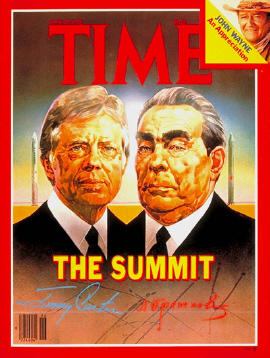
The Democrat controlled congress and much of the
American public thought the SALT II treaty was not good for the
U.S.
not
imposing limits on the development of new weapons systems. Ultimately, SALT II would fail to gain
congressional approval even though the congress was controlled by President Carter’s own party,
the Democrats. | | |
|
|
|
149.
|
The purpose of SALT II was
to
a. | Increase trade between the U.S. and
Soviets | c. | Improve cultural
contacts between the U.S. and the Soviets | b. | reduce nuclear arms between the U.S. and the Soviet
Union | d. | Drive a wedge between Russia and
China |
|
|
|
150.
|
SALT II
was
a. | a new treaty between the U.S. and
the Soviets enacted into law in the U.S. | c. | a defeat for President Carter | b. | a congressionally approved attempt to limit U.S. nuclear
arms | d. | a success for President
Carter |
|
|
|
151.
|
SALT II was signed by
a. | Carter and Brezhnev
| c. | Reagan and
Gorbachev | b. | Carter and Andropov | d. | Carter and Gorbachev |
|
|
|
Ronald Reagan had a different philosophy and approach to communism than
President Jimmy Carter. In 1981, Ronald Reagan -- a strident Cold Warrior -- enters the White House
on a platform of "making America strong again." Convinced the United States is lagging in
the arms race, Reagan increases defense spending and proposes a "Star Wars" anti-missile
system -- alarming leaders in Moscow.
Reagan reasoned that he could increase the chances of peace
by eliminating the threat of a nuclear attack by the Soviets. He offered to share the technology with
the Soviets.
| | | |
|
|
|
152.
|
From the passage we can infer
that Ronald Reagan was
a. | a pro-Soviet
president | c. | a moderate
regarding communism | b. | a strong anti-communist | d. | a president with socialist
tendencies |
|
|
|
153.
|
The Soviets were most likely
a. | more afraid of Carter than
Reagan | c. | equally fearful of Carter and
Reagan | b. | more afraid of Reagan than Carter | d. | not very concerned with Carter of
Reagan |
|
|
|
REAGAN
At his first press conference as president, Ronald Reagan rendered a tough
verdict on the policy of détente, calling it "a one-way street the Soviet Union has used to
pursue its own aims." Reagan's message was unmistakable: The only way to deal with the
Kremlin was from a position of strength.
Immediately, he began a new phase of rearmament. He
increased the defense budget by $32.6 billion. He approved production of the costly B-1 bomber, a
project President Carter had scrapped. He expanded the size of the Navy. And new defense guidelines
called for preparations to wage a nuclear war "over a protracted period."
| The renewed arms race and Reagan's anti-Soviet rhetoric revived the
anti-nuclear movement in Western Europe. Reagan was portrayed by a vocal minority of Americans and
many Europeans as a warmonger. Yet, in truth, Reagan shared their antipathy for nuclear brinksmanship
-- the policy known as "mutual assured destruction."
| | |
|
|
|
154.
|
In dealing with the Soviets,
Reagan believed the U.S. needed to deal from a position of strength. What did he do to make America
stronger?
a. | Spent money to make the U.S.
military the most powerful in the world. | c. | Spent more money on social programs like
Medicare | b. | Spent more money on education | d. | Made the U.S. work more with the United
Nations |
|
|
|
155.
|
Which idea was most likely
believed by Reagan?
a. | It is more important that your enemy
like you than respect you | c. | Do not do anything to make your enemies
upset | b. | If you are nice to your enemies they will be nice to
you | d. | It is more important to be respected than
loved. |
|
|
|
156.
|
How did Reagan feel about MAD
(mutual assured destruction)
a. | was in favor of
it | c. | was unconcerned about
it | b. | was opposed to
it | d. | did not know what it
was |
|
|
|
TENSION
In Moscow, Andropov (leader of the Soviet Union) responded
defiantly to Reagan's "Star Wars" plan. "All attempts at achieving military
superiority over the U.S.S.R. are futile," he said. Privately, however, Andropov was frightened
by SDI and Reagan's anti-Soviet speeches. In one of his speeches Reagan called the Soviet Union
the, “Evil Empire.” Convinced that the West was planning for war, Andropov ordered a
worldwide alert. The KGB monitored every aspect of life in the West.
The Americans stepped up spy
flights in sensitive areas along the Soviet Union's long borders. Aircraft packed with
electronic surveillance gear and disguised as civilian airliners often flew close to passenger
routes.
On August 31, 1983, a South Korean airliner left Anchorage for Seoul. For reasons still
unexplained, KAL Flight 007, with 269 people on board, ended up in Soviet air space, more than 300
miles from its normal route. Every indication was that the airliner was a civilian plane. After
firing several warning tracer shots across the plane's bow, a Soviet fighter pilot downed the
carrier, killing everyone on board. Reagan called the incident "an act of barbarism." The
American people, and the people of the world were outraged.
| 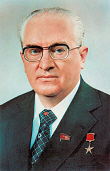
 | | |
|
|
|
157.
|
It is safe to say that the
Soviets and Andropov were
a. | unconcerned about the U.S. and
Reagan | c. | unconcerned about the U.S. because
they had weapons just as good as the U.S. | b. | alarmed by Reagan and his
policies | d. | concerned about American policies
but liked and trusted Ronald Reagan |
|
|
|
158.
|
The shooting down of flight KAL
007
a. | helped to prove Reagan’s
statement that the Soviet Union was an evil empire | c. | improved relations between South Korea and the Soviet
Union | b. | made the American people more sympathetic towards the Soviets because it was a
mistake | d. | made people more fearful of Soviet technology
|
|
|
|
159.
|
KAL 007 was a civilian airliner
belonging to _____ shot down by _____
a. | the United States - the Soviet
Union | c. | North Korea -
China | b. | the United States - China | d. | South Korea - the Soviet Union |
|
|
|
GORBACHEV
A mood of crisis now gripped both East and West. Arms
control talks were broken off. The Soviet leadership even believed a nuclear attack by the West was
imminent. Reagan was surprised when told the Kremlin seriously feared an American first-strike
offensive. It was time, he told aides, for a face-to-face meeting with Soviet leaders.
But to
whom in the Kremlin could Reagan talk peace? In February 1984, Yuri Andropov died. His successor,
Konstantin Chernenko, was too frail to start a dialogue and died a year later -- the third aged
Soviet leader to die in three years.
Party leaders knew the country needed new blood. They turned
to 54-year-old reformer Mikhail Gorbachev -- who in a speech the year before had introduced the
concepts of "perestroika" (restructuring) and "glasnost" (openness) to the
Communist Party lexicon. At a party plenum to ratify his election by the Politburo, Gorbachev pledged
to make the Soviet Union more democratic -- and announced his intention to stop the arms
race.
| 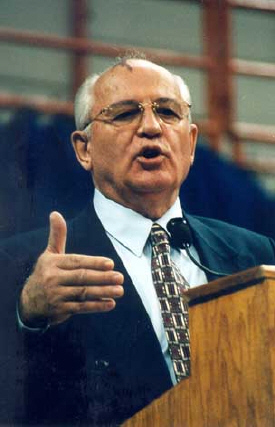 | | |
|
|
|
160.
|
The Soviets
were
a. | not afraid of the U.S. under
Reagan | c. | afraid of Reagan but sure he would
not attack the Soviet Union | b. | afraid the U.S. under Reagan might attack the Soviet
Union | d. | more concerned about domestic issues than foreign
affairs |
|
|
|
161.
|
Why did Reagan want a face to
face meeting with the leader of the Soviet Union?
a. | spy on the Soviet
Union | c. | ease tensions between the two
countries | b. | to get trade concessions from the Soviets | d. | warn the Soviets that the U.S. might attack at any
time |
|
|
|
162.
|
What Soviet leader started the
idea of perestroika" (restructuring) and "glasnost"
(openness)
a. | Andropov | c. | Gorbachev
| b. | Khrushchev | d. | Brezhnev |
|
|
|
RAPPORT
In November 1985, Gorbachev traveled to Geneva to meet
with Reagan for the first superpower summit in six years.
At their first face-to-face meeting,
the two leaders outlined their positions in adversarial terms -- arguing about regional conflicts and
accusing each other of trying to divide the world. Gorbachev later told aides Reagan was not just a
conservative, but "a political dinosaur." Later that day, the tenor of the dialogue
changed. Though the two leaders remained divided by Reagan's "Star Wars" initiative,
the atmosphere grew warmer -- they established a rapport. Gorbachev left Geneva without agreement on
his main objective -- curbing the arms race -- but the United States and the Soviet Union were
talking again.
One year into the Gorbachev era the Cold War continued. The Geneva call for a
second summit was repeatedly postponed. Fears of nuclear war remained. In April 1986, an explosion
ripped apart a reactor at the Chernobyl nuclear power plant in Ukraine north of Kiev. The disaster
highlighted the incompetence of the Soviet system. The Soviets were weak economically,
scientifically, and their infrastructure was poor.
| 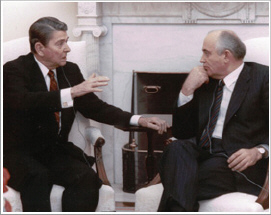
Personal Friendship develops between Reagan and
Gorbachev
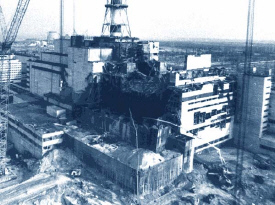 Soviet Powerplant at Chernobyl explodes killing thousands and spreading radiation
throughout Europe Soviet Powerplant at Chernobyl explodes killing thousands and spreading radiation
throughout Europe | | |
|
|
|
163.
|
What was the main result of the
first meeting between Reagan and Gorbachev at Geneva in
1985?
a. | Reagan and Gorbachev confirmed that they could not trust each other | c. | Gorbachev became convinced that he could manipulate Reagan
any way he wanted. | b. | A new arms reduction treaty was agreed to by the Soviets and the
U.S. | d. | The two men established a rapport and a basis for trust
between them |
|
|
|
164.
|
In the 1985 Geneva summit,
Reagan and Gorbachev learned to _____ each other.
a. | respect | c. | distrust | b. | hate | d. | fear |
|
|
|
165.
|
What happened at Chernobyl ?
a. | Soviet nuclear missile
exploded | c. | Ukrainian water
power plant exploded | b. | Soviet nuclear power plant exploded | d. | The U.S. attacked a Ukrainian power
plant |
|
|
|
166.
|
What did Chernobyl illustrate to the world?
a. | Strength of the Soviet
economy | c. | The power of the
Soviet infrastructure | b. | Serious weaknesses in all phases of Soviet
society | d. | The power of Soviet Science and
technology |
|
|
|
REYKJAVIK
Six months after the Chernobyl disaster, Reagan and
Gorbachev went to Reykjavik, Iceland, for their second summit. No one expected much of substance to
emerge.
But over the next few days, the two leaders took a series of bold and unexpected steps
aimed at reducing the threat of nuclear war. Gorbachev seized the initiative, winning Reagan's
backing for a comprehensive set of reductions of strategic arms, intermediate-range missile and space
weapons. Next, the two leaders agreed on the complete withdrawal of intermediate-range missiles in
Europe and a 50 percent reduction in ballistic missiles over a five-year period.
As the talks
continued, Reagan and Gorbachev each raised the ante in their quest for arms reductions. Finally,
Reagan stunned Gorbachev and his own advisers by offering to eliminate all nuclear weapons in 10
years, effectively abolishing the nuclear deterrent. But Gorbachev continued to press Reagan on
"Star Wars." "Our meeting cannot produce one winner. We both either win or lose,"
he said. Reagan would not budge.
The summit ended without an agreement -- but each delegation
realized the discussions had crossed a historic line. In 1987, Reagan and
| 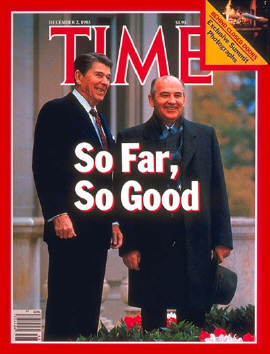
Gorbachev met in Washington to sign the Intermediate-range Nuclear Forces (INF)
Treaty -- eliminating an entire class of U.S. and Soviet nuclear arms for Eastern and Western Europe.
Reagan's defense of "Star Wars" prevented further progress in arms talks for the
remainder of his presidency. Nevertheless, two leaders a generation apart had brought their two
countries closer then they had been in 40 years. | | |
|
|
|
167.
|
At Reykjavik, Iceland, Reagan and Gorbachev
a. | laid the foundation for a series of
major arms reduction measures | c. | could not agree on any arms reduction
measures | b. | agreed to develop “star wars”
together. | d. | left angry and distrustful of each
other. |
|
|
|
168.
|
What was the big surprise
proposal made by Reagan at the Reykjavik, Iceland
summit?
a. | that Reagan would be NICE to the
Soviet Union from now on and stop calling them names. | c. | that the U.S. was willing to end Star Wars | b. | Reagan made no surprise
proposal | d. | that both nations would eliminate
ALL nuclear arms |
|
|
|
169.
|
Many people in the United
States and Europe thought that Star Wars was a fantasy and could not be achieved. How did the Soviets
feel about Star Wars?
a. | They were afraid of
it | c. | They did not concern themselves with
it | b. | They agreed that it was a
fantasy | d. | All of these are true of the
Soviets |
|
|
|
170.
|
Reagan believed that Star Wars
was protection for the American people against nuclear missile attack. He also knew that if he agreed
with Gorbachev to get rid of Star Wars, he could go down in history as the president who ended the
cold war. Reagan refused to get rid of Star Wars showing that he was _____ president who _____
.
a. | a weak - who would do anything to
become famous | c. | a strong - cared
more for the people than his own legacy | b. | a cruel - who cared little for the American
people. | d. | an evil - who put the destruction of the Soviet Union
ahead of the safety of the American people |
|
|
|
171.
|
Reagan was a strong Republican
conservative. Many people give him credit for winning the cold war because he built up the military
to a point where the Soviets could no longer keep up. Of all the presidents during the cold war, it
was Reagan who came up with the bold ideas that finally ended the cold war. Gorbachev agreed to an
end of the cold war because he trusted Reagan.
|
|
|
For nearly three decades, the Berlin Wall
symbolized the Iron Curtain that separated East from West. But by 1989, the Wall was starting to
crumble -- and by the end of the year it would collapse.
FIRST CRACK
In December 1988, Soviet leader Mikhail Gorbachev met with outgoing U.S. President
Ronald Reagan and his successor, George Bush. Gorbachev had decided that the Cold War must end -- and
that Soviet control over the Communist bloc nations must be loosened. He told the peoples of Eastern
Europe that they had the right of self-determination. But his listeners -- including those in the
United States -- were skeptical of the Soviet response if non-Communist leaders were elected.
In
Hungary, where Soviet tanks smashed an uprising in 1956, people were again growing angry. Economic
reforms had met with disaster, and the Communist Party was losing control. In fear, the leadership
promised more democracy -- and planned for multi-party elections. Hungarian Prime Minister Miklos
Nemeth went to Moscow to inform Gorbachev -- who didn't approve but promised no repeat of 1956.
Hungarian reforms included the rehabilitation of the 1956 uprising's leaders. Executed
leader Imre Nagy and his comrades were given a public funeral, and the government declared the
revolution justified. A month earlier, the Hungarian government made an even bolder move, taking down
the barbed wire on its border with Austria and the West. The Soviet Union did nothing. Although
travel was still not completely free, the Iron Curtain was starting to unravel.
| |
|
|
|
172.
|
Who succeeded Ronald Reagan as
President of the U.S.?
a. | Gorbachev | c. | Gerald Ford | b. | George Bush | d. | Henry Kissinger |
|
|
|
173.
|
What communist leader believed
that Soviet domination of Eastern Europe must end?
a. | Ronald
Reagan | c. | Kosegan | b. | Mikhail Gorbachev | d. | Nikita Khrushchev |
|
|
|
174.
|
In 1956 the Soviet Union put
down a revolution in Hungry with tanks. They killed thousands of people including the leader of the
revolution. In 1989 the communist party in Hungry agreed to allow free elections, they honored the
leaders of the 56 revolution as heroes and took down the barbed wire between Hungry and Vienna. What
did this show?
a. | that Hungry was now a capitalist
country | c. | that the communist
party and the Soviets were loosing control in Hungry | b. | that the Soviets no longer cared what the Hungarians
did | d. | that the communist party was as strong as ever in
Hungry |
|
|
|
175.
|
Because of their long history
of repression, most people in the West did not believe the Soviets when they said they wanted reforms
in East Europe
|
|
|
POLAND
The Poles, like the Hungarians, were breaking with the
communist system. Faced with a wave of political strikes led by the Solidarity opposition movement,
the communist regime had given way. In early 1989, government leaders opened talks with Solidarity
and were prepared to share power and discuss a shift toward democracy.
In June, elections were
held -- and produced a stunning defeat for the communists. Solidarity won 99 out of 100 seats in the
Senate. Within weeks, the first anti-communist prime minister in the Soviet bloc took office. At a
Warsaw Pact summit in July, Eastern bloc leaders were divided. East Germany's Erich Honecker and
Romania's Nicolae Ceausescu were alarmed by events in Poland and Hungary. Some say they even
conspired to urge Soviet intervention.
At about the same time, U.S. President Bush visited Poland
and Hungary, giving them moral support for democratic change -- but little else. Back in the United
States, Bush's secretary of state, James Baker, assured his Soviet counterpart, Eduard
Shevardnadze, that the West would tread carefully in Eastern Europe and not exploit Soviet problems
there.
| |
|
|
|
176.
|
What was the movement that
opposed communist dictatorship in Poland called?
a. | Solidarity | c. | The
AFL-CIO | b. | The Polish League | d. | The Catholic League |
|
|
|
177.
|
Which two Eastern European
leaders were against the freedom movements in Poland and Hungry?
a. | Goering and
Mussolini | c. | Gorbachev and
Khrushchev | b. | Erich Honecker and Eduard
Shevardnadze | d. | Erich Honecker and Nicolae
Ceausescu |
|
|
|
178.
|
Who was President Bushes
Secretary of State in 1989?
a. | Henry
Kissinger | c. | James
Baker | b. | Gerald Ford | d. | Colin Powell |
|
|
|
179.
|
What did President Bush promise
the Soviet Union?
a. | That he would not use the problems
in Poland to make the Soviets look bad | c. | That he would not cut off aid to Russia | b. | That he would send aid to
Poland | d. | That he would not remove American troops from West
Germany |
|
|
|
EXODUS
In East Germany, Erich Honecker refused to admit there was
anything wrong with his system -- but in reality, the country was rotting away. Pollution poisoned
the air and water. The economy was running down. The police state provoked mass suspicion and stifled
all initiative.
In the summer of 1989, East Germans rushed to take vacations in Hungary -- where
the border with the West was weakening -- and besieged the West German Embassy in Budapest, demanding
help to emigrate.
In Berlin, Honecker called the refugees moral outcasts and blocked further
travel to Hungary. Desperate, the fleeing East Germans turned to Czechoslovakia -- and gathered at
the West German Embassy in Prague. Refugees crammed themselves into the embassy and refused to leave
-- until, under Soviet and West German pressure, Honecker consented to a face-saving deal: The
refugees could go to West Germany, but only if their train crossed East German territory first. Then
Honecker could claim he had expelled them and canceled their
citizenship
| |
|
|
|
180.
|
Where did the East Germans go
to escape East Germany control?
a. | Hungary than
Poland | c. | Czechoslovakia then Romania | b. | Poland then Czechoslovakia | d. | Hungary then Czechoslovakia |
|
|
|
181.
|
From all of the events that
were happening in Eastern Europe in Poland, Hungary, Czechoslovakia and
East Germany, it was easy to see that
a. | the people did not want to be
capitalist | c. | the communist
system was strong | b. | the communist system was falling apart | d. | the Soviet Union had control of the
situation |
|
|
|
182.
|
What was Honeker afraid
of
a. | That Germany would be unified under
communism | c. | That Germany would
be united and communism would end in East Germany | b. | That Germany would be divided into East and
West | d. | That West Germany would become
communist |
|
|
|
PROTEST
Some East Germans chose to stay and protest. Inspired by
Gorbachev, they dreamed of turning their country into a democracy. Weekly demonstrations in Leipzig
soon swelled into mass protests. Police tried to stop them, but the government was losing its nerve.
Only Honecker seemed confident of his country's future. As he welcomed Gorbachev to Berlin
on the eve of East Germany's 40th anniversary in October 1989, he pretended not to notice when a
group of communist youth marchers dropped their rehearsed slogans and began to chant "Gorby,
save us!"
The Soviet leader's visit had in fact galvanized protests against the deeply
unpopular Communist regime. Gorbachev suggested to Honecker that the way to stop public protest
engulfing his government would be to introduce a German version of perestroika. Honecker would not
listen -- he was planning to stamp out the new opposition. Some feared a repeat of the Chinese
crackdown against dissidents earlier that year in Tiananmen Square. An internal plot was hatching
against Honecker. A group in the East German Politburo had decided it was time for him to
go.
| |
|
|
|
183.
|
Why did East German youths
chant, "Gorby, save us!" to Gorbachev?
a. | they wanted him to support
Honecker | c. | they wanted him to
stamp out the protests | b. | they wanted him to save them from Western
democracy | d. | They wanted him to bring the same
kind of openness he had brought to Russia |
|
|
|
184.
|
In the Eastern Europe protests,
who was the hard liner that took a firm position against the protestors?
a. | Gorbachev | c. | Gorbachev and Honecker | b. | Honecker | d. | Neither were hard liners |
|
|
|
185.
|
Why were public protests
engulfing the government of East Germany
a. | the protestors wanted to remain
communist | c. | the protestors
wanted the war in Afghanistan to end | b. | the protestors wanted to go to the United
States | d. | the protestors wanted Western style
freedom |
|
|
|
TURNING
POINT
A protest rally was
planned for two days later in Leipzig. The East German army was on alert, and the city was in a state
of emergency. As the demonstration began, 70,000 people were on the streets. Alarmed, the Soviet
ambassador telephoned the commander of Soviet forces in the region -- and ordered them not to
interfere. Local Communist Party leaders begged the opposition to talk. Then, without higher orders,
officials pulled back the police and troops. The demonstration went off peacefully. For East Germans,
this was the turning point.
Deserted by his allies, Honecker was voted out of power by the entire
Politburo on October 17. Egon Krenz took charge, promising to implement democratic reforms -- and
make it easier for East Germans to travel West, the issue that had set off the whole crisis. On
November 1, he traveled to Moscow, where Gorbachev urged him to ease travel restrictions. Krenz
offered East Germans new freedoms, but demonstrators wanted more
| |
|
|
|
186.
|
In the passage above it is easy
to see that
a. | East Germany had given in to the
protestors | c. | West Germany was
not very appealing to East Germans | b. | East Germany was taking a firm stand against the
protestors | d. | West Germany wanted to be
communist |
|
|
|
187.
|
What do you think was the
main reason most East Germans
wanted to travel to West Germany
a. | to see how people in West Germany
lived | c. | the weather was better in West
Germany | b. | to visit friends and relatives in West
Germany | d. | the West Germans were giving away free beer and
pretzels |
|
|
|
188.
|
When the East German communists
went to Gorbachev for advice, what did he tell them to do.
a. | take military action against the
demonstrators | c. | close the German
borders | b. | grant more freedom to the demonstrators | d. | ignore the demonstrators and the situation would go away by
itself |
|
|
|
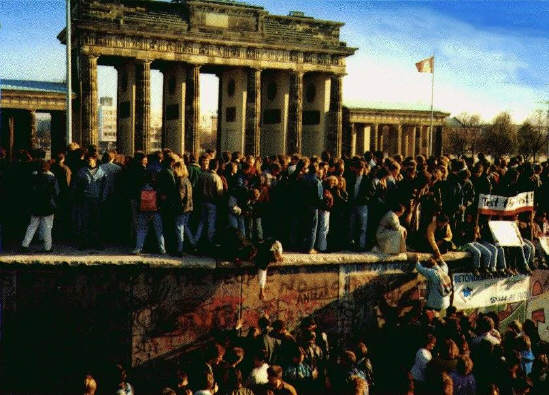
REUNION
With
street protests mounting, and thousands of people fleeing the country daily, East Germany was on the
verge of disintegration. On November 9, East German Politburo member Gunter Schabowski told
journalists in Berlin that restrictions on travel to the West would be lifted. The government meant
the change to start the next day. But Schabowski mistook the timing -- and told reporters the change
was immediate. The news flashed around the city. East Berliners rushed to see if the checkpoints in
the Wall were really opening. Borders guards were baffled. They had only one order -- to stop anyone
trying to escape. But the crowds were huge. Suddenly, the guards gave in and opened the barriers.
West Berliners arrived from the other direction and began to demolish the Wall in front of the
Brandenburg Gate. Across the Wall, two worlds had faced each other in arms. Now their enmity was
dumped into history. Germany would be reunited. Europe's revolution against communism would
continue throughout the rest of East Europe. The cold war was over.
| |
|
|
|
189.
|
Who planned and organized the
revolt in East Germany against communism?
a. | the CIA | c. | no one. it was an uprising by ordinary
people | b. | the KGB | d. | the Soviets |
|
|
|
190.
|
The East German border guards
were ordered to stop people from crossing into West Germany. What did they do when thousands of East
Germans showed up at the border to cross into the West?
a. | Strung barbed wire across the
border | c. | Started shooting at the
protestors | b. | Asked the Soviet Union for tanks and support | d. | Gave up and let the people pass |
|
|
|
191.
|
The U.S. won the cold war
because the democratic ideals espoused by the United States finally defeated communism.
|
Matching
|
|
|
a. | 
Henry
Kissinger | e. | 
Robert McNamara | b. | 
Ngo Dinh
Diem | f. | 
Ho Chi
Minh | c. | 
Lyndon
Johnson | g. | 
Richard
Nixon | d. | 
General William
Westmorland | h. | 
John F
Kennedy |
|
|
|
192.
|
Kennedy Secretary of Defense
who went to work for the Johnson administration and was the main architect of the war in
Vietnam
|
|
|
193.
|
In charge of American Military
forces in Vietnam
|
|
|
194.
|
Leader of North
Vietnam
|
|
|
195.
|
President of South Vietnam,
who was assassinated in a coup
|
|
|
196.
|
Nixon’s foreign policy
advisor who finally negotiated an end to the Vietnam war
|
|
|
197.
|
President of the U.S. who is
identified with the Vietnam war
|
|
|
198.
|
President who finally ended
the Vietnam War
|
|
|
199.
|
This President was in office
when the Vietnam war started
|
Short Answer
|
|
|
200.
|
Explain the Monroe Doctrine
(your own words)
|
Problem
|
|
|
201.
|
Explain how President
Nixon’s trip to China effected the U.S., China and the Soviet Union.

|